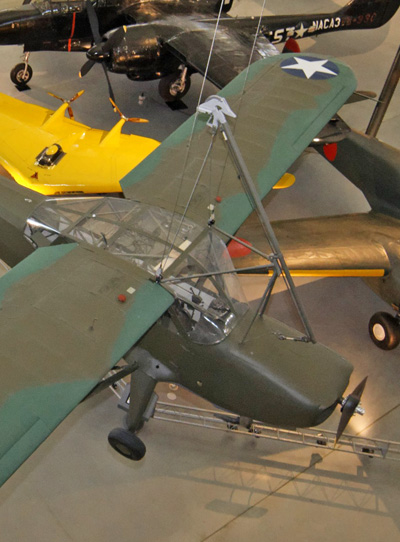Brodie Landing Systems — no need for an airstrip
Brodie Landing Systems — no need for an airstrip
Aircraft are wonderful machines that are good for many uses, one of which is to get into remote regions for scouting or exploration missions. Aircraft types that are best for these purposes are often small and not in need for much in the way of an airstrip. During WW II, in the Pacific and Burma Theaters of Operation, the U.S. forces often were advancing into terrain that was either jungle or mountainous or even both.
Writer’s note: the information trail for this post began with a sign for an aircraft display in the National Air & Space Museum Steven F Udvar-Hazy Center. Suspended from the ceiling and easily seen from the central stairway landing is a Stinson L-5 Sentinel with a trapeze-like rig mounted so that it reached above the wing. There is no explanation about this unusual appendage except to say that it is a Brodie rig as well as photo of a light aircraft flying into a fabric loop.

NASM plaque for the Brodie Landing System equipped Stinson L-5 Sentinel engaging the loop for "landing" — photo by Joe May
Later, after I returned home, a search on the web led me to a copyrighted article by Irwin J. Kappes, which can be found here. I’ve summarized the high points in the text below but I suggest that you read Kappes’ article as it is informative and goes into more detail than I can here.
Captain James H. Brodie (USAAF) had been working on a solution that would allow a small aircraft, such as the Stinson L-5 Sentinel or Piper L-4 Cub , to operate without the need for either an airstrip or aircraft carrier. His design was essentially a cable suspended between two masts — the cleverness is in the details, especially the pulleys and arresting gear — with the masts erected either on land or on the port side of a ship. Only a bulldozer and a pair of 2½ ton trucks were needed to carry the gear and set up the Brodie rig for a land based operation. The needs for a water borne operation were a vessel no larger than an LST (Landing Ship Tank).
Brodie was able to test his designs and make improvements with the aid of test pilot F/O Raymond Gregory and the good ship City of Dalhart. Details of the design can be found here — where one can see detailed technical drawings and the patent numbers should further research be required.
Although meeting with operational success in the Battle for Okinawa it never gained widespread use, with the advent of helicopters likely ending any future need for the innovative Brodie Landing System. Piloting during landing was challenging as the LST mother ship would roll and the arms suspended from the mast made for a moving, swinging target window for the pilot. A window that was small indeed as the propeller could not be allowed to strike the steel cable. Upon contact with the loop the pilot had to then work against instinct and force the control stick forward, diving to the sea only feet below, to engage the snagging hook. All of this done in less than 600 feet (182m).
Think of it, whether in the jungle or aboard ship, the Brodie Landing System rigged aircraft could stay in the air and never need to touch ground, water, snow or ice — no other aircraft placed into operation can make the same claim, with the exception* of air ship based aircraft.
* See the post Parasite Fighter Aircraft Attempts — a 3fer, which published 26 August 2009. Pasting the title in the search window and selecting ENTER will get you there quickly.
References
Airstrip in the Air, James L H Peck, March 1946 in Popular Science
The Secret Weapon of the Pacific War, Irwin J. Kappes, 2003





Raymond Gregory Is my great grandfather and I have been doing a large amount of research looking for somebody to clarify the question on if the aircraft he flew (The L-5 Sentinel) was in the museum in D.C or the Udvar-Hazy Center. My school is going to visit the museum in D.C this month and I was very hopeful his plane would be stored there so I could see it. Now that I know its in Virginia I’ll have to plan another trip out that way but thats okay its part of the experience.
I’m glad you found where the L-5 with the Brodie system is on display. You will like it at the Udvar-Hazy as it is huge, You can see that aircraft, if it hasn’t been relocated, from a stairway landing where you will be almost next to it. You won’t be disappointed. Enjoy.
Thank You so much!
Thank You so much!